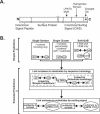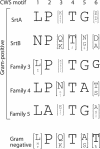A comparative genome analysis identifies distinct sorting pathways in gram-positive bacteria
- PMID: 15102780
- PMCID: PMC387863
- DOI: 10.1128/IAI.72.5.2710-2722.2004
A comparative genome analysis identifies distinct sorting pathways in gram-positive bacteria
Abstract
Surface proteins in gram-positive bacteria are frequently required for virulence, and many are attached to the cell wall by sortase enzymes. Bacteria frequently encode more than one sortase enzyme and an even larger number of potential sortase substrates that possess an LPXTG-type cell wall sorting signal. In order to elucidate the sorting pathways present in gram-positive bacteria, we performed a comparative analysis of 72 sequenced microbial genomes. We show that sortase enzymes can be partitioned into five distinct subfamilies based upon their primary sequences and that most of their substrates can be predicted by making a few conservative assumptions. Most bacteria encode sortases from two or more subfamilies, which are predicted to function nonredundantly in sorting proteins to the cell surface. Only approximately 20% of sortase-related proteins are most closely related to the well-characterized Staphylococcus aureus SrtA protein, but nonetheless, these proteins are responsible for anchoring the majority of surface proteins in gram-positive bacteria. In contrast, most sortase-like proteins are predicted to play a more specialized role, with each anchoring far fewer proteins that contain unusual sequence motifs. The functional sortase-substrate linkage predictions are available online (http://www.doe-mbi.ucla.edu/Services/Sortase/) in a searchable database.
Figures



Similar articles
-
Sorting sortases: a nomenclature proposal for the various sortases of Gram-positive bacteria.Res Microbiol. 2005 Apr;156(3):289-97. doi: 10.1016/j.resmic.2004.10.011. Epub 2005 Jan 28. Res Microbiol. 2005. PMID: 15808931 Review.
-
Characterization of Streptococcus suis genes encoding proteins homologous to sortase of gram-positive bacteria.J Bacteriol. 2002 Feb;184(4):971-82. doi: 10.1128/jb.184.4.971-982.2002. J Bacteriol. 2002. PMID: 11807057 Free PMC article.
-
An embarrassment of sortases - a richness of substrates?Trends Microbiol. 2001 Mar;9(3):97-102. doi: 10.1016/s0966-842x(01)01956-4. Trends Microbiol. 2001. PMID: 11239768 Review.
-
A comprehensive in silico analysis of sortase superfamily.J Microbiol. 2019 Jun;57(6):431-443. doi: 10.1007/s12275-019-8545-5. Epub 2019 May 27. J Microbiol. 2019. PMID: 30900148
-
The biology of Gram-positive sortase enzymes.Trends Microbiol. 2004 Feb;12(2):89-95. doi: 10.1016/j.tim.2003.12.007. Trends Microbiol. 2004. PMID: 15036325 Review.
Cited by
-
Contribution of individual Ebp Pilus subunits of Enterococcus faecalis OG1RF to pilus biogenesis, biofilm formation and urinary tract infection.PLoS One. 2013 Jul 11;8(7):e68813. doi: 10.1371/journal.pone.0068813. Print 2013. PLoS One. 2013. PMID: 23874774 Free PMC article.
-
The SrtA Sortase of Streptococcus agalactiae is required for cell wall anchoring of proteins containing the LPXTG motif, for adhesion to epithelial cells, and for colonization of the mouse intestine.Infect Immun. 2005 Jun;73(6):3342-50. doi: 10.1128/IAI.73.6.3342-3350.2005. Infect Immun. 2005. PMID: 15908360 Free PMC article.
-
Sortase A substrate specificity in GBS pilus 2a cell wall anchoring.PLoS One. 2011;6(10):e25300. doi: 10.1371/journal.pone.0025300. Epub 2011 Oct 4. PLoS One. 2011. PMID: 21991306 Free PMC article.
-
Complete genome sequence of Finegoldia magna, an anaerobic opportunistic pathogen.DNA Res. 2008 Feb 29;15(1):39-47. doi: 10.1093/dnares/dsm030. Epub 2008 Feb 7. DNA Res. 2008. PMID: 18263572 Free PMC article.
-
Mechanism for sortase localization and the role of sortase localization in efficient pilus assembly in Enterococcus faecalis.J Bacteriol. 2009 May;191(10):3237-47. doi: 10.1128/JB.01837-08. Epub 2009 Mar 13. J Bacteriol. 2009. PMID: 19286802 Free PMC article.
References
-
- Ajdic, D., W. M. McShan, R. E. McLaughlin, G. Savic, J. Chang, M. B. Carson, C. Primeaux, R. Tian, S. Kenton, H. Jia, S. Lin, Y. Qian, S. Li, H. Zhu, F. Najar, H. Lai, J. White, B. A. Roe, and J. J. Ferretti. 2002. Genome sequence of Streptococcus mutans UA159, a cariogenic dental pathogen. Proc. Natl. Acad. Sci. USA 99:14434-14439. - PMC - PubMed
-
- Baba, T., F. Takeuchi, M. Kuroda, H. Yuzawa, K. Aoki, A. Oguchi, Y. Nagai, N. Iwama, K. Asano, T. Naimi, H. Kuroda, L. Cui, K. Yamamoto, and K. Hiramatsu. 2002. Genome and virulence determinants of high virulence community-acquired MRSA. Lancet 359:1819-1827. - PubMed
Publication types
MeSH terms
Substances
Grants and funding
LinkOut - more resources
Full Text Sources
Other Literature Sources
Molecular Biology Databases

